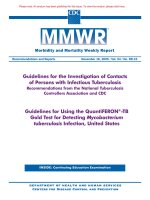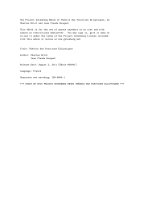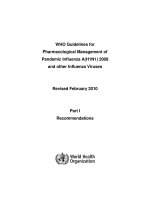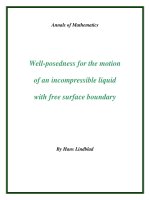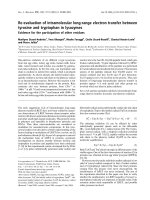Egg parasitic fungus, Engyodontium aranearum with other biocontrol agents, organic amendment and carbofuran for the management of Meloidogyne incognita on tomato
Bạn đang xem bản rút gọn của tài liệu. Xem và tải ngay bản đầy đủ của tài liệu tại đây (179.24 KB, 9 trang )
Int.J.Curr.Microbiol.App.Sci (2017) 6(5): 29-37
International Journal of Current Microbiology and Applied Sciences
ISSN: 2319-7706 Volume 6 Number 5 (2017) pp. 29-37
Journal homepage:
Original Research Article
/>
Egg Parasitic Fungus, Engyodontium aranearum with other Biocontrol
Agents, Organic Amendment and Carbofuran for the Management of
Meloidogyne incognita on Tomato
M. Muthulakshmi*, B. Anita and S. Subramanian
Department of Nematology, Tamil Nadu Agricultural University,
Coimbatore – 641 003, India
*Corresponding author
ABSTRACT
Keywords
Engyodontium
aranearum,
Biocontrol agents,
P. flouroscens, Root
knot nematode,
Meloidogyne
incognita, Tomato.
Article Info
Accepted:
04 April 2017
Available Online:
10 May 2017
The effect of Engyodontium aranearum, a nematode egg parasitic fungus, alone
and along with other biocontrol agents, organic amendment and carbofuran was
evaluated in pot culture infested with Meloidogyne incognita on tomato under pot
and field condition for two seasons. Plant growth parameters, fruit yield, root
population and final nematode population were determined at harvest. The results
revealed that all the treatments were effective in increasing the plant growth with
significant reductions in nematode populations. Among the treatments, the
combined soil application of E. aranearum with P. flouroscens each at 2.5 kg/ha
increased the tomato yield by 55.68 per cent under pot culture conditions and
41.62 per cent under field conditions. The soil nematode population was decreased
by 54.74 per cent under pot culture and 60.75 under field conditions. There was
also significant reduction in nematode population in roots.
Introduction
India's diverse climate ensures availability of
all varieties of fresh fruits and vegetables. It
ranks second in vegetables production in the
world, after China. India produced 146.554
million metric tonnes of vegetable from 8.495
million hectares. Tomato is the world’s
largest and important commercial vegetable
grown in tropical and subtropical areas for its
fleshy fruits, taste and nutritive value. It is a
short duration crop and gives high yield. In
India, tomato occupies second position
amongst the vegetable crops in terms of
production. Total production of tomato in the
country was 17.4 mt from an area of 0.87 mha
().
In
Tamil
Nadu, tomato occupies an area of 0.02 mha
with production of 0.29 mt (http://www.
tn.gov.in).
Tomato is affected adversely by several pests,
diseases and nematodes, which result in heavy
yield losses. Plant parasitic nematodes are the
major pests of agriculture throughout the
world, which cause 12.3 per cent yield losses
(Sassar and Freckman, 1987) with a global
economic impact of more than $125 billion
annually worldwide (Chitwood, 2003).
Among crop plants, vegetables are highly
susceptible to root knot nematodes. The
southern root knot nematode, Meloidogyne
29
Int.J.Curr.Microbiol.App.Sci (2017) 6(5): 29-37
incognita is one of the major constraints in
the production of tomato in tropical and
subtropical regions. In India, the annual losses
caused by root knot nematode, M. incognita
are 27.2 per cent in tomato (Jain et al., 2007).
Present strategies for nematode management
largely depend on cultural practices, use of
resistant varieties and chemical applications
often in combinations (Hague and Gowen,
1987). A large number of beneficial
organisms including fungi, bacteria, viruses
and predatory nematodes have been found to
parasitize the infective juveniles, female and
eggs of root knot and cyst nematodes
(Stirling, 1991).
pots containing pot mixture. The tomato
plants were inoculated @ one J2/g of soil on
15 days after transplanting. The experiment
was conducted under glasshouse conditions in
a completely randomized design (CRD) with
the following treatments which were
replicated three times.
1 – E. aranearum @ 2.5 kg/ha
2– E. aranearum @ 2.5 kg/ha + P. lilacinus
@ 2.5 kg/ha
3 – E. aranearum @ 2.5 kg/ha + T. viride @
2.5 kg/ha
4 - E. aranearum @ 2.5 kg/ha + P. fluorscens
@ 2.5 kg/ha
5- E. aranearum @ 2.5 kg/ha + Neem cake
(250kg/ha)
6 - E. aranearum @ 2.5 kg/ha + Carbofuran
3G @ 1 kg a.i./ha
7 – Control
The
egg parasitic
fungi,
Pochonia
chlamydosporia and Paecilomyces lilaciuns
have been associated with soils which
suppress the multiplication of cyst nematode
populations (Kerry et al., 1993). The egg
parasitic fungus, Engyodontium aranearum
parasitization of the potato cyst nematodes
was first reported from The Nilgiris
(Muthulakshmi, 2011). Hence, the present
investigation was under taken with Egg
parasitic fungus, Engyodontium aranearum
alone and with other biocontrol agents,
organic amendment and carbofuran in tomato
under pot and field conditions to assess the
effectiveness against Meloidogyne incognita.
Two field experiments were conducted in
nematode sick field of Madhampatti and
Karadimadai village, Coimbatore district,
Tamil Nadu to evaluate E. aranearum
formulation against M. incognita in tomato
(cv. Co3) and in bhendi (Mahyco hybrid No.
10) respectively. The experiment was
conducted in a randomized block design
(RBD) with treatments and replications
similar to glasshouse experiment.
Plant growth parameters viz., shoot length,
shoot weight, root length, root weight and
yield were observed at after harvest. The
observations on soil and root population of
root knot nematode, number of females/5 g
root, number of egg masses/5g root and root
knot index were recorded at after harvest.
Materials and Methods
The compatibility of E. aranearum with other
biocontrol agents viz., Trichoderma viride, P.
lilacinus, Pseudomonas fluorescens and
organic amendment, neem cake and
carbofuran was studied under pot culture and
field conditions.
The data from the experiments were subjected
to statistical analysis. The treatment means
were compared by Duncan’s Multiple Range
Test (DMRT) (Gomez and Gomez, 1984).
The package used for analysis was
IRRISTAT version 92-1 by International Rice
Soil application of E. aranearum against M.
incognita was carried out under pot culture
conditions in tomato. Tomato seeds (cv. Co 3)
were sown in pots and maintained for 25
days. After that seedlings were transplanted in
30
Int.J.Curr.Microbiol.App.Sci (2017) 6(5): 29-37
Research
Institute,
Philippines.
Biometrics
Unit,
Results and Discussion
seed treatment with combination of P.
fluorescens, T. viride and P. lilacinus reduced
the infestation of M. phaseolina and H. cajani
complex in black gram.
Pot culture experiment
Field experiments
In tomato, E. aranearum significantly
improved plant growth parameters when
applied either alone or in combination with
other biocontrol agents, organic amendments
and carbofuran. The highest shoot length
(66.39 cm), root length (17.62cm), shoot
weight (22.67g), root weight (13.48g) and
yield (628.37 g/plant) were recorded in plants
treated with E. aranearum (2.5kg/ha) +P.
fluorescens (2.5 kg/ha) compared to 40.47cm,
10.54cm, 12.98g, 7.85g and 403.62 g/plant,
shoot length, root length, shoot weight, root
weight and yield respectively in untreated
control (Table 1). There was a significant
decrease in no. of females, number of egg
masses, root knot index, root population and
soil population in both the combined and
individual treatments compared to untreated
control.
In tomato, the highest shoot length (73.48
cm), root length (35.52cm), shoot weight
(28.52g), root weight (17.38g) and yield
(24.67 t/ha) was recorded in plants treated
with E. aranearum (2.5kg/ha) + P.
fluorescens (2.5 kg/ha) compared to 45.57
cm, 21.84 cm, 17.58 g, 11.54 g and 17.42
t/ha, shoot length, root length, shoot weight,
root weight and yield respectively in
untreated control (Table 3).
There was a significant decrease in no. of
females, no. of egg masses, root knot index,
root population and soil population in both the
combined and individual treatments compared
to untreated control.
The combined application of E. aranearum
(2.5 kg/ha) + P. fluorescens (2.5 kg/ha)
reduced the number of females and number of
egg masses by 63.47 and 61.85 per cent over
control. There was also 61.95 and 60.75 per
cent reduction in the nematode population in
roots and soil. These findings were in
agreement with the Gopinatha et al., (2002)
obtained significant increase in plant growth
and yield of tomato and reduction in root
galling
in
combinations
of
V.
chlamydosporium + carbofuran, marigold +
carbofuran, V. chlamydosporium + marigold
(Table 4).
The combined application of E. aranearum
(2.5 kg/ha) + P. fluorescens (2.5 kg/ha)
reduced the number of females and number of
egg masses by 51.53 and 61.33 per cent over
control. There was also 52.00 and 54.74
percent reduction in the nematode population
in roots and soil (Table 2). These findings
were in agreement with the egg parasitic
fungus, P. lilacinus in combination with V.
chlamydosporium significantly increased the
length and weight of root and shoot and
reduced root galling in okra plant (Sobita
Simon and Avinash Pandey, 2010).
The
combined
application
of
P.
chlamydosporia with neem cake and/or
carbofuran at reduced doses gave better
recovery in comparison to either of the single
application in terms of shoot length, shoot
weight, root length and fruit yield.
Kumar and Prabhu (2008) reported that
combined application of T. harzianum + P.
chlamydosporia significantly reduced the cyst
nematode H. cajani population in pigeon pea.
Latha and Narashimhan (2001) reported that
31
Int.J.Curr.Microbiol.App.Sci (2017) 6(5): 29-37
Table.1 Compatibility of E. aranearum with other biocontrol agents, organic amendments and carbofuran
on plant tomato under pot culture conditions
Shoot length
(cm)
53.54e
(32.30)
58.78cd
(45.24)
58.42d
(44.35)
66.39a
(64.05)
60.73c
(50.06)
64.72b
(59.92)
Root length
(cm)
14.19d
(34.63)
15.38c
(45.92)
15.30c
(45.16)
17.62a
(67.17)
15.54c
(47.44)
17.04b
(61.67)
Shoot
weight (g)
18.46d
(42.22)
19.30c
(48.70)
19.23c
(48.15)
22.67a
(74.65)
19.86c
(53.00)
21.38b
(64.71)
Root weight
(g)
10.64e
(35.54)
11.42d
(45.48)
11.63d
(48.15)
13.48a
(71.72)
12.46c
(58.73)
13.04b
(66.11)
Yield
(g/plant)
536.59d
(32.94)
550.38d
(36.36)
554.62d
(37.41)
628.37a
(55.68)
585.61c
(45.09)
607.38b
(50.48)
Control
40.47f
10.54e
12.98e
7.85f
403.62e
SEd
CD (P=0.05)
0.9479
2.0332
0.2486
0.5332
0.3160
0.6778
0.1899
0.4073
9.0880
19.4940
Treatments
E. aranearum@ 2.5 kg/ha
E. aranearum@ 2.5 kg/ha + P. lilacinus
@ 2.5 kg/ha
E. aranearum@ 2.5 kg/ha + T. viride @
2.5 kg/ha
E. aranearum@ 2.5 kg/ha + P.
fluorscens @ 2.5 kg/ha
E. aranearum@ 2.5 kg/ha + Neem cake
(250kg/ha)
E. aranearum@ 2.5 kg/ha + Carbofuran
3G @ 1 kg a.i./ha
Values are mean of three replications. Column figures followed by different letters are significant from each other at 5 per cent level by DMRT
32
Int.J.Curr.Microbiol.App.Sci (2017) 6(5): 29-37
Table.2 Effect of E. aranearum alone and along with other biocontrol agents, organic amendments and carbofuran on tomato infested
with M. incognita under pot culture conditions
No. of
females
(5g root)
No. of egg
mass
(5g
root)
Root knot
index
Root
population
(5g root)
Soil
population
(250cc soil)
E. aranearum@ 2.5 kg/ha
63.82e
(33.81)
29.27e
2.33
81.73e
(34.99)
111.54d
(45.49)
(41.89)
E. aranearum@ 2.5 kg/ha +
P. lilacinus @ 2.5 kg/ha
60.41d
(37.34)
26.98d
(46.44)
2.00
77.93d
(38.01)
106.58c
(47.92)
E. aranearum@ 2.5 kg/ha +
T. viride @ 2.5 kg/ha
60.53d
(37.22)
26.76d
(46.87)
2.00
76.47d
(39.17)
106.83c
(47.80)
E. aranearum@ 2.5 kg/ha +
P. fluorscens @ 2.5 kg/ha
46.73a
(51.53)
19.48a
(61.33)
1.33
60.35a
(52.00)
92.63a
(54.74)
E. aranearum@ 2.5 kg/ha +
Neem cake (250kg/ha)
57.48c
(40.39)
23.52c
(53.31)
2.00
69.32c
(44.86)
102.62c
(49.85)
E. aranearum@ 2.5 kg/ha +
Carbofuran 3G @ 1 kg
a.i./ha
49.39b
(48.78)
21.83b
(56.66)
1.67
64.48b
(48.71)
97.38b
(52.41)
Control
96.42f
50.37f
4.33
125.72f
204.64e
SEd
1.0447
0.4897
-
1.3378
2.0058
CD (P=0.05)
2.2408
1.0504
-
2.8696
4.3025
Treatments
Values are mean of three replications. Column figures followed by different letters are significant from each other at 5 per cent level by DMRT
33
Int.J.Curr.Microbiol.App.Sci (2017) 6(5): 29-37
Table.3 Effect of E. aranearum alone and along with other biocontrol agents, organic amendments and carbofuran on plant growth
parameters in tomato under field contidions
(Pooled data from two field experiments)
Shoot
length
(cm)
Root
length
(cm)
Shoot
weight (g)
Root
weight (g)
Yield (t/ha)
E. aranearum@ 2.5 kg/ha
62.42e
(36.98)
30.62f
(40.20)
24.38f
(38.68)
15.26f
(32.24)
21.73f
(24.74)
E. aranearum@ 2.5 kg/ha + P.
lilacinus @ 2.5 kg/ha
65.43d
(43.58)
32.16e
(47.25)
25.89d
(47.27)
15.86e
(37.44)
22.65e
(30.02)
E. aranearum@ 2.5 kg/ha + T.
viride @ 2.5 kg/ha
65.72d
(44.22)
32.42d
(48.44)
25.75e
(46.47)
15.93d
(38.04)
22.78d
(30.77)
E. aranearum@ 2.5 kg/ha + P.
fluorscens @ 2.5 kg/ha
73.48a
(61.25)
35.52a
(62.64)
28.52a
(62.23)
17.38a
(50.61)
24.67a
(41.62)
E. aranearum@ 2.5 kg/ha + Neem
cake (250kg/ha)
69.35c
(52.18)
33.48c
(53.30)
26.85c
(52.73)
16.12c
(39.69)
23.56c
(35.25)
E. aranearum@ 2.5 kg/ha +
Carbofuran 3G @ 1 kg a.i./ha
71.43b
(56.75)
34.64b
(58.61)
27.74b
(57.79)
16.46b
(42.63)
24.14b
(38.58)
Control
45.57f
21.84g
17.58g
11.54g
17.42g
SEd
0.1522
0.0735
0.0597
0.0311
0.0385
CD (P=0.05)
0.3317
0.1601
0.1300
0.0677
0.0839
Treatments
Values are mean of three replications. Column figures followed by different letters are significant from each other at 5 per cent level by DMRT
34
Int.J.Curr.Microbiol.App.Sci (2017) 6(5): 29-37
Table.4 Effect of E. aranearum alone and along with other biocontrol agents, organic amendments and carbofuran on root knot
nematodes in tomato under field conditions
(Pooled data from two field experiments)
No. of
females
(5g root)
No. of egg
mass
(5g root)
Root knot
index
Root
population
(5g root)
Soil
population
(250cc soil)
E. aranearum@ 2.5 kg/ha
72.12f
(34.66)
35.64f
(33.57)
2.33
124.54f
(34.55)
147.38f
(40.05)
E. aranearum@ 2.5 kg/ha + P.
lilacinus @ 2.5 kg/ha
66.26e
(39.97)
31.48e
(41.32)
2.00
112.53e
(40.86)
130.84e
(46.78)
E. aranearum@ 2.5 kg/ha + T.
viride @ 2.5 kg/ha
65.39d
(40.75)
30.68d
(42.81)
2.00
110.47d
(41.94)
128.62d
(47.68)
E. aranearum@ 2.5 kg/ha + P.
fluorscens @ 2.5 kg/ha
40.32a
(63.47)
20.47a
(61.85)
1.33
72.41a
(61.95)
96.48a
(60.75)
E. aranearum@ 2.5 kg/ha + Neem
cake (250kg/ha)
54.74c
(50.40)
27.93c
(47.94)
2.00
86.72c
(54.43)
109.52c
(55.45)
E. aranearum@ 2.5 kg/ha +
Carbofuran 3G @ 1 kg a.i./ha
45.38b
(58.88)
23.28b
(43.39)
1.67
75.36b
(60.40)
99.73b
(59.43)
Control
110.37g
53.65g
4.33
190.28g
245.84g
SEd
0.3779
0.1761
-
0.6615
0.8407
CD (P=0.05)
0.8233
0.3836
-
1.4412
1.8317
Treatments
Values are mean of three replications. Column figures followed by different letters are significant from each other at 5 per cent level by DMRT
35
Int.J.Curr.Microbiol.App.Sci (2017) 6(5): 29-37
The combination of P. chlamydosporia,
carbofuran and neem cake gave highest yield
of okra and suppressed root knot nematode
severity in terms of galling, egg production
and nematode population with a marginal
difference with dual application of biocontrol
agent and carbofuran in okra (Dhawan and
Satyendra Singh, 2009). Cannayane and
Rajendran (2001) reported that single
applications of either P. lilacinus, P.
chalmydosporia or oil cakes suppressed M.
incognita. Nagesh et al., (2000) reported that
combined application of P. lilacinus + T.
harzianum + neem cake effectively controlled
M. incognita in gladiolus. P. fluorescens with
T. viride, B. subtilis, P. lilacinus and VAM
reduced the population of R. similis, P.
coffeae and Helicotylenchus multicinctus in
banana cv. Robusta (Shanthi et al., 2003).
Rao (2005) studied the bio-efficacy and
compatibility of P. chlamydosporia and P.
lilacinus on M. javanica infecting nursery
seedlings of acid lime and found that
application of 5 or 10 g/kg soil of each
bioagent significantly reduced the root galling
and number of nematodes in roots.
Service. Pest Management Sci., 59:
748-753.
Dhawan, S.C. and Satyendra Singh. 2009.
Compatibility
of
Pochonia
chlamydosporia with nematicide and
neem cake against root knot nematode,
Meloidogyne incognita infesting okra.
Indian J. Nematol., 39: 85-89.
Gomez, K.A. and Gomez, A.A. 1984.
Statistical procedures for agricultural
research, second edn. Wiley, New York,
US.
Gopinatha, K.V., Nanjegowda, D. and
Nagesh, M. 2002. Management of root
knot nematode, Meloidogyne incognita
on tomato using bio-agent Verticillium
chlamydosporium, neem cake, marigold
and carbofuran. Indian J. Nematol., 32:
179-181.
Hague, N.G.M. and Gowen, S.R. 1987.
Chemical control of nematodes. In:
Principles and Practice of Nematode
Control in Crops. Brown, R.H., Kerry,
B.R. (Eds.). Australia Academic Press,
pp. 133-178.
Jain, R.K., Mathur, K.N. and Singh, R.V.
2007. Estimation oflosses due to Plant
Parasitic Nematodes on differentcrops
in India. Indian J. Nematol., 37: 219 –
221.
Kerry, B.R., Kirkwood, I.A. De Leij,
F.A.A.M. Barba, J. Leijdens, M.B. and
Brookes, P.C. 1993. Growth and
survival
of
Verticillium
chlamydosporium Goddard, a parasite
of nematodes in soil. Biocontrol Sci.
Technol., 3: 355-365.
Latha, T.K.S. and Narashimhan, V. 2001.
Management of root rot and cyst
nematode complex in black gram. Plant
Dis. Res., 16: 73-78.
Muthulakshmi, M. 2011. Biomanagement of
potato cyst nematodes, Globodera
rostochiensis (wollen weber) and G.
pallida (stone) using egg parasitic fungi
in potato. Ph.D. Thesis, Tamil Nadu
Acknowledgements
The authors are thankful to Societal Research
Fellowship Scheme (WOS-B), Department of
Science and Technology, New Delhi who
provided necessary funds for operating the
scheme work.
References
Cannayane, I. and Rajendran, G. 2001.
Application of biocontrol agents and oil
cakes for the management of
Meloidogyne incognita in brinjal. Curr.
Nematol., 12: 51-55.
Chitwood, D.J. 2003. Research on plant parasitic nematodebiology conducted by
the
United
State
Department
ofAgriculture-Agriculture
Research
36
Int.J.Curr.Microbiol.App.Sci (2017) 6(5): 29-37
Agricultural University, Coimbatore,
India.
Nagesh, M., Reddy, R.R. Ramachander, N.
and Menta, M. 2000. Integrated
management of Meloidogyne incongita
and Fusarium oxysporum sp. Gladioli in
gladiolous using antagonistic fungus
and neem cake. In: 3rd International
Symposium Nematology Challenges
and Opportunities in 21st century
conducted Afro-Asian Society of
Nematologists (TISAAN) held at
Sugarcane
Breeding
Institute,
Coimbatore, pp. 16-19.
Prabhu, S., Kumar, S. Subramanian, S. and
Senthil Kumar, P. 2008. Mass
production and Commercial formulation
of Paecilomyces lilacinus. Indian J.
Nematol., 38: 131-133.
Rao,
M.S.
2005.
Management
of
Meloidogynejavanica on acid lime
nursery seedlings by using formulations
of Pochonia chlamydosporia and
Paecilomyces lilacinus. Nematologia
Mediterranea, 33: 145-148.
Sasser, J.N. & Freckman, D.W. 1987. A
world perspectivein Nematology: Role
of Society. In: Vistas on Nematology
(Ed. I.A. Veech & D.W. Dickson), pp.
7-14.
Shanthi, A., Rajendran, G. and Sivakumar, M.
2003. Bio-management of lesion
nematodes in Banana. In: 6th
International workshop on plant growth
promoting rhizobacteria, Bangalore,
India. pp. 58-63.
Sobita Simon, L. and Avinash Pandey. 2010.
Antagonistic efficacy of Paecilomyces
lilacinus
and
Verticillium
chlamydosporiun against Meloidogyne
incognita infecting okra. Indian J.
Nematol., 40: 113.
Stirling, G.R. 1991. Biological control of
plant parasitic nematodes- Progress,
problems
and
prospects.
CAB
International, Wallingford, UK. 282p.
http://www. tn.gov.in
How to cite this article:
Muthulakshmi, M., B. Anita and Subramanian, S. 2017. Egg Parasitic Fungus, Engyodontium
aranearum with Other Biocontrol Agents, Organic Amendment and Carbofuran for the
Management of Meloidogyne incognita on Tomato. Int.J.Curr.Microbiol.App.Sci. 6(5): 29-37.
doi: />
37

